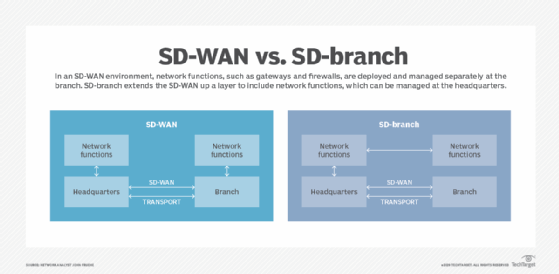
alex_aldo - Fotolia
What's the difference between SD-branch vs. SD-WAN?
As networking pros evaluate SD-branch vs. SD-WAN, they'll notice a key distinction between the two technologies, namely how network functions are managed and orchestrated.
The difference between software-defined branch and software-defined WAN largely entails where network functions are managed. But, before we dissect the key differences between SD-branch vs. SD-WAN any further, let's first examine SD-WAN architecture.
The focus on branch office connectivity and applications has received a boost from SD-WAN, which creates a virtual overlay on top of existing branch office transports, which include MPLS, broadband Ethernet and 3G or 4G, among others. Ultimately, SD-WAN aims to enable better management and control of the connectivity between headquarters and branches.
With SD-WAN, businesses have a virtual control channel between the headquarters and branch offices that enables better orchestration of communications and policies. Because of this innovation, many organizations are looking at other network functions deployed at the branch to see if a complementary service could assist those functions as well.
With SD-WAN, the connectivity is virtualized, and both sides can be orchestrated and automated to optimize management and control. Though the WAN connection is now optimized and can be managed seamlessly from the headquarters, the network functions -- such as gateways, firewalls and security -- are still deployed and managed separately.
Comparing SD-branch vs. SD-WAN
SD-WAN is strictly focused on the transport and the data flowing over that transport. SD-branch, on the other hand, is a newer concept that extends the orchestration and control beyond just the pipe and up to network functions.
The concept of SD-branch is inclusive of these network functions, extending the SD-WAN up a layer to include network functions. These functions can now be managed at the headquarters level and orchestrated together across both sides of the WAN connection. The ability to view and manage these network functions together helps to streamline operations and make IT more efficient.

A wide range of vendors are offering SD-branch services. Each vendor is taking a slightly different approach since SD-branch currently has no standard implementation.
Vendors such as networking giant Cisco Systems, LAN and Wi-Fi-focused Aruba Networks, and even startups like Versa Networks all have a different approach to SD-branch. This fragmentation is similar to the way SD-WAN remains a technology with multiple deployment methodologies and no true interoperability standard to date.








